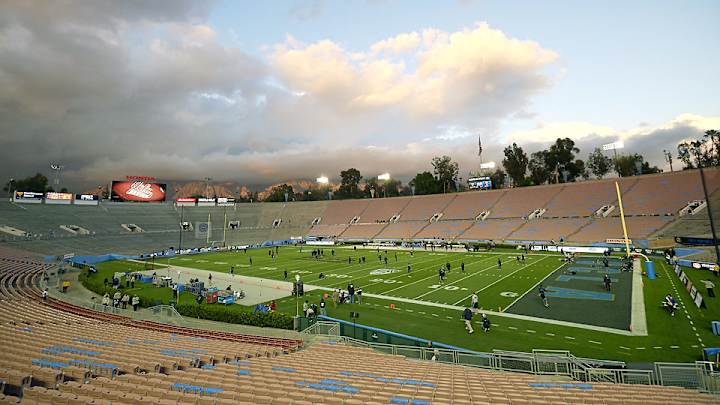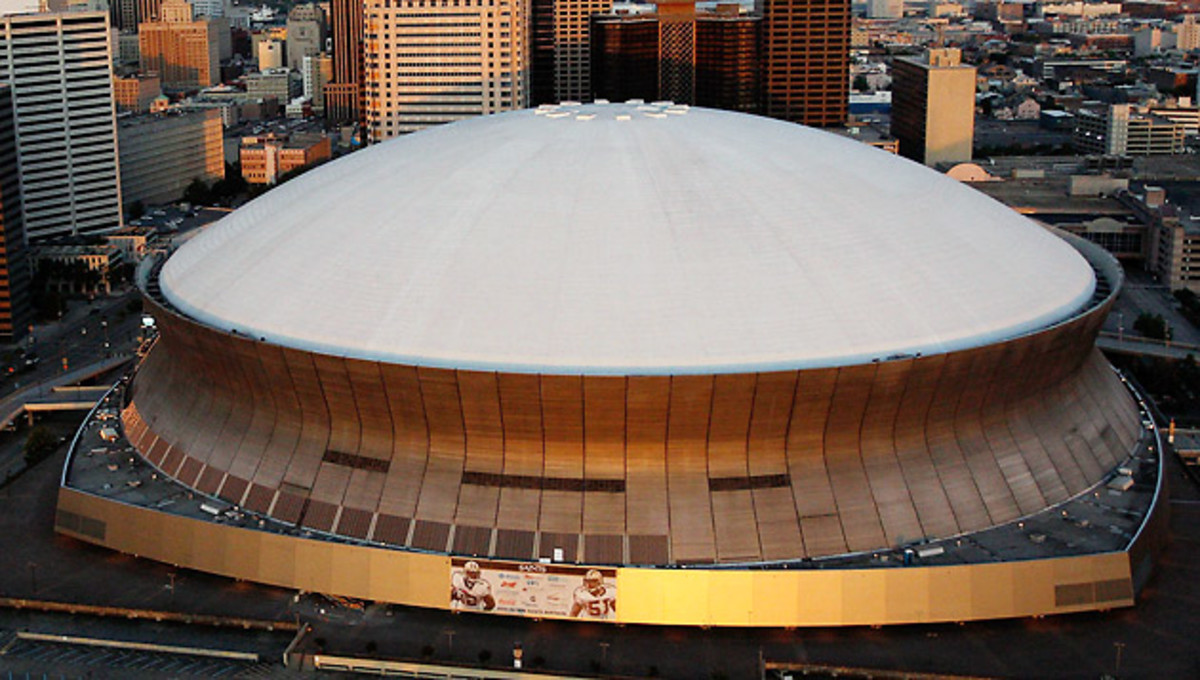Stadium Spotlight: Superdome, Rose Bowl set to host first playoff games

New Year’s Day football conjures up plenty of memories and traditions. Think of the Rose Bowl and the Sugar Bowl. And now that those two games start the new tradition of the College Football Playoff, how fitting that the two venues offer up plenty of history in and of themselves. First Oregon will face Florida State in the Rose Bowl in Pasadena, and then Alabama will play Ohio State in New Orleans’ Superdome. Two vastly varied venues with a shared purpose: stage college football’s finest for the nation to enjoy.
Rose Bowl
Setting and history. Those -- well, and the weather -- make the Rose Bowl, home of UCLA since 1982, a national landmark and celebrated football stadium no matter which coast you’re on.
Opened in 1922 with 57,000 seats, the Tournament of Roses Association and designer Myron Hunt modeled the Los Angeles venue after Yale's stadium bowl. Fittingly, the Rose Bowl and the Yale Bowl represent two of only four stadiums listed as National Historic Landmarks (Harvard Stadium and the Los Angeles Memorial Coliseum round out the list).
The atmosphere at the Rose Bowl fits the environment. Adorned with pillars aplenty, the natural grass turf ties to the vegetation all around the venue, including trees that reach above the top of the stadium’s famed rim.
• STAPLES: Rose Bowl matches Heisman QB vs. Heisman QB
Seating about 92,500, “the Rose Bowl has the best setting of any stadium in the world,” Darryl Dunn, the slightly biased Rose Bowl general manager, tells SI.com. “Nestled in the mountains, trees literally overhanging the top rows of the stadium, beautiful homes all around it and usually the weather is pretty good. It is just beautiful.”
Rose Bowl fans can tailgate on the 36-hole golf course adjacent to the stadium, setting the tone for the Southern California feel within.
The venue has hosted five Super Bowls and is the only stadium in the world to host a men’s World Cup final, a women’s World Cup final and an Olympic gold medal soccer match.
From early on, the Rose Bowl had success in its location within a ravine of parkland and natural vegetation on the west side of Pasadena. USC defeated Penn State during the first game there in 1923, and by 1928 the stadium had already jumped 19,000 seats to a capacity of 76,000 when expansion enclosed the horseshoe with a southern stand and gave that top rim a circumference of 2,430 feet. In 1931, concrete replaced wooden sections and capacity grew again, this time to 83,000 seats in time to host cycling events during the 1932 Summer Olympics.
By 1950 capacity extended to nearly 101,000, and that year’s Rose Bowl game became the first bowl game to have over 100,000 fans on site. The capacity ballooned to 104,500 by 1972 as the Rose Bowl continued to host mega event after mega event, from the 1984 Summer Olympics to World Cup finals, with improvements and renovations all along the way.
The Rose Bowl isn’t done improving, though. Dunn says they have tried to upgrade the stadium while retaining its historic character as part of an ongoing renovation project. Eight tunnels in the end zone were doubled in width to move people in and out easier, and new aisles mean no more 40-row seats. Remade exits at the field level, a new video board and completely updated electrical wiring -- “a huge undertaking,” Dunn says -- throughout the venue have already occurred. The new Terry Donahue Pavilion houses all the Rose Bowl’s premium seating, media and key operations. As the stadium renovation continues during the offseason, expect to see even wider concourses by 2018 with new gates and upgraded restrooms and concessions.
Not everything will transform at the Rose Bowl. Whether the steepness of the bowl that starts shallow and builds as it moves higher or sightlines pointing toward midfield, don’t expect a change in the history and setting of the 92-year-old stadium.

Superdome
Forget the field, the new-every-year UBU artificial turf, at the Superdome. To create a modern atmosphere -- New Orleans style, of course -- a 2011 renovation welcomed fans to Champions Square.
“In a city built around great public squares, what better than to create an event space for the ultimate pre-game party in a public square,” Paul Griesemer, AECOM architect, tells SI.com. The square combines music, food and a grand staircase to the stadium for a New Orleans-styled party area fit for either the NFL’s Saints or the Sugar Bowl.
Opened in 1975, the Superdome of 2015 looks nothing like it did nearly 40 years prior, thankfully, mind you.
The roughly 73,000-seat venue, one of the largest domes in the world, covers 13 acres with its steel frame and has long been an attraction for major events due to its size and location. Then, in 2005, the building’s history took a new twist, serving as a lackluster rescue location for Hurricane Katrina survivors.
Following the New Orleans disaster, questions surfaced over whether the Superdome -- which had undergone damage both inside and outside, along with now carrying a less-than-desirable stigma for those who took shelter there -- was worth saving, even if it could be done. Ultimately, the damage to the Superdome, which had lost 70 percent of its roof membrane and been riddled with water damage, mold, vandalism and other issues, was deemed mostly cosmetic.
“The structure and backbone systems were the primary concerns,” Griesemer says. “If any of them hadn’t survived, replacement costs would have been substantial and prohibitive. The primary structure was unaffected.”
• THAMEL: Can Ohio State shock Alabama in the Sugar Bowl?
But that didn’t mean help wasn’t needed. The facility underwent a complete refurbishing, opening in time for the 2006 NFL season. Everything from new concessions and suites to new ductwork and electrical systems gave the Superdome new life.
That new life improved in 2011 when structural renovations tripled the width of the Superdome's concourse and updated its amenities, along with little extras like the Champions Square.
“The design team also recognized that the Superdome stands as an iconic symbol for the city and the region,” Griesemer says. “Its shape and scale were respected as the beacon that it is, even through a total reskining of the stadium and adding fenestrations [openings], which the building never had.”
As the Sugar Bowl hopes to keep the lights on throughout its big event on Jan. 1 -- unlike the 2013 Super Bowl -- Griesemer says the Champions Square space should help to create a prime college atmosphere before the big game. Plus, the “dome environment” serves to focus noise onto the field.
The Rose Bowl and Superdome have proven no strangers to football stadium history and now host the beginnings of college football's new postseason legacy.
Tim Newcomb covers stadiums, design and gear for Sports Illustrated. Follow him on Twitter at @tdnewcomb.
